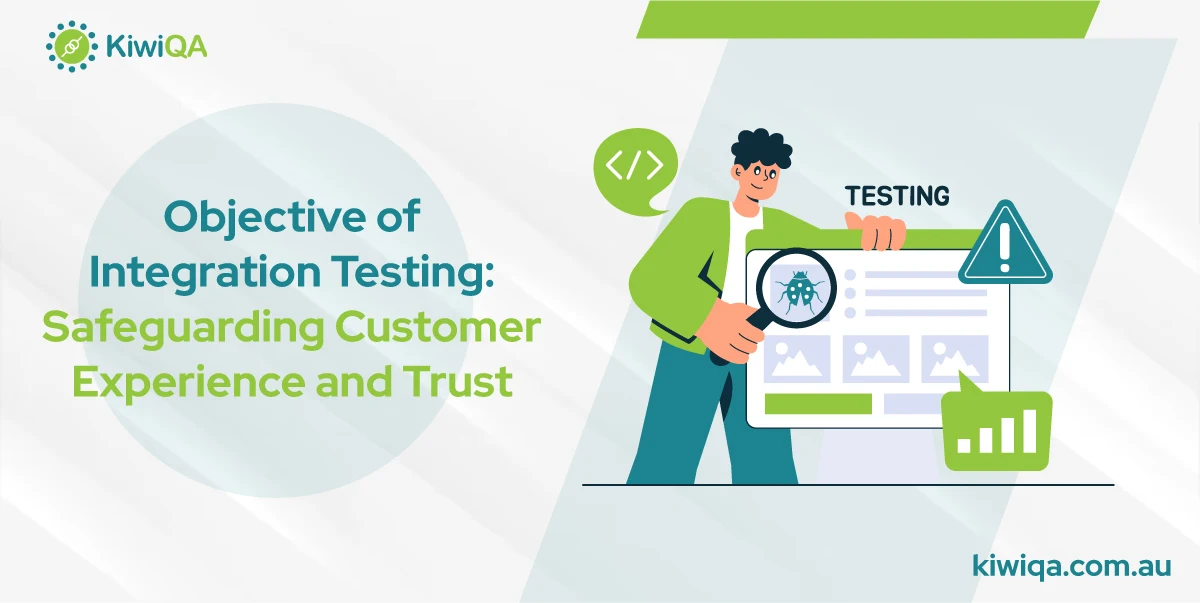Objective of Integration Testing: Safeguarding Customer Experience and Trust

 KiwiQA
KiwiQAIn the landscape of SDLC, verifying that the system components work flawlessly has become a necessity. To measure the system’s robustness & reliability, it is necessary to monitor how well the components work together. To bring your business into the tech world, your ultimate goal should be designing an app with well-organized software & functional features. In the SDLC workflow, software testing is the crucial phase, focused on reliability, functionality & software performance.
Have you ever tried to understand why an app works flawlessly but suddenly falls down when connected with another system? If your application breaks down during the data mismatch, broken API, or time conflicts, integration testing plays a strong role. Companies that avoid integration testing face 30 to 40% of high maintenance costs that ultimately increase the requirement for rework.
In the current tech world, integration testing isn’t an option but an essential. The key objective of integration testing is to verify that the software components interact seamlessly when integrated. Software integration testing method varies from top-down & bottom-down approaches to sandwich & big-bang integration. Each method has its unique traits & challenges.To select the best module, hire a professional testing partner & ask them to select according to business requirements.
Integration testing aims to validate that the various parts of the software work together while integrated. The aim of integration testing is to collect major software components and ensure they communicate simultaneously. The key objective of integration testing is to maintain data integrity & improve performance. Integration testing is followed by unit testing, where the QA team has already tested various components before moving to UAT. At this phase, integration testing verifies that when you integrate multiple components, they work together as part of an extensive system.
To understand it through an example, let’s assume that you have an e-commerce site, you might have separate modules for the payment, user management & inventory. By utilizing system integration testing, you can verify that every module interacts perfectly; otherwise, you will end up with failed payments & other glitches. Through integration testing, you can test situations involved-
Integration testing assists in enhancing the test procedure & overall product quality by verifying that the interface is bug-free. When dealing with integration testing, the selection of ideal tools & technologies can give better outcomes. Some popular tools are Jira, Jenkins & SoapUI, which seamlessly connect with each module.
Unit testing is a software testing type where every system component is tested. The testing is carried out throughout the app development. Unit testing is performed by the developer to test every individual module for evaluating whether there are any loopholes. Similarly, system testing is performed to evaluate whether the software matches specific needs. It is performed by the developers & testers. Here, check the brief summary of the distinction between unit, system, and integration testing-
The role of software in user experience is crucial for your organization’s success. Businesses should focus on app functionality to craft intuitive & effective interactions which match user needs & drive loyalty. Good software UX incorporates accessibility, usability & consistent design to reduce user frustration & enhance overall user satisfaction. Focusing on user experience drives engagement & retention. Furthermore, the objective of integration testing is to build a positive brand image & ultimately enhance ROI.
Every software bug & system failure over time gradually hampers digital products & users’ confidence. The most overlooked way software error damages user trust is through unexplained & subtle inconsistencies. Hidden errors cause uncertainty that further leads to credibility issues. In some cases, the application quietly drops data without any visible sign.
Errors create confusion, inconsistencies, and doubt. They erode user trust by disrupting the app functionality, causing data loss and organization competence. Furthermore, it drains billions from companies every year. Apart from financial loss, errors result in broken features, lost customers & slow growth.
Bugs and system failures erode user trust by disrupting functionality, causing data loss, and creating frustrating user experiences that damage brand reputation and loyalty. When software is unreliable, users lose confidence in its dependability and the organization’s competence, which can lead to customer dissatisfaction, negative word-of-mouth, and a competitive disadvantage.
App downtime can be more complicated for business. A study said an average outage costs $5600 per minute. However, for companies like Amazon, it can cause damage of $2.6 million. To navigate this scene, it is recommended to collaborate with the testing partner. The impact can be significantly reduced by approaching proactive practices.
Broken integration can lead to reputation damage, financial loss, data inconsistencies & operational inefficiencies. Broken integration results in reductions in the productivity of employees and significant security errors. In a real-world example, a broken integration in CRM & marketing systems can lead to incomplete customer data, whereas in supply chain integration, it can cause hindrance in inventory management & customer service.
Also Read: The Future of Software Delivery AI-Driven Automation Testing Processes
The key objective of integration testing is to validate that the data flows smoothly between the modules. The testing team frequently verifies data consistency between the modules to validate that the right information is delivered and no data is lost during integration operations. The major aim of integration assessment is to verify that the various software components & subsystems work together to achieve the expected performance & functionality. It addresses & resolves the loopholes that arise during the workflow like compatibility & performance errors.
Finding interface defects earlier in the deployment process can limit the complexity & cost. Integration testing is the major phase in SDLC, which aims to address the interface errors & verify that the interactions & data exchange between the modules are secure. It catches mismatched API contracts & validates 3rd party service integrations.
The Objective of integration testing is to minimize the system-level failure by systematically validating the interaction between the modules. They make sure the data communication & exchange are done perfectly before the system is deployed. The initial monitoring of integration errors is costly to fix later. So, ultimately, it improves reliability while saving unnecessary repair costs.
The key objective of integration testing is to ensure consistency by verifying that individual software modules function cohesively when integrated. It addresses potential errors & ensures a unified experience that users are expecting. In some cases, individual components have better UX, but when combined with others, the user experience can be confusing. The integration test ensures the UX is working consistently across the modules.
By confirming component interactions, identifying communication glitches, and data problems early, integration testing helps to minimize major disruptions in client journeys. It guarantees smooth data flow across modules and APIs. Software testing may be automated to identify problems after every code change by incorporating testing into CI/CD pipelines. This reduces the feedback loop, lowers the need for expensive post-deployment modifications, and eventually improves the overall quality and dependability of the software.
Users won’t interact with the isolated components. They want a platform where they can go through the full workflow from browsing to adding to the cart. Integration testing validates that the flows work from start to finish. A minor failure or system breakdown in between the flow can break users’ trust permanently.
Integration testing examines the interface connections between various software components. Integration testing is used in the following real-world industry applications:
Integration testing in e-commerce software verifies that the product recommendations, shopping cart, payment gateway & other inventory management systems are working effectively. Approaching this test, avoid payment failure and incorrect order delivery to improve customer satisfaction.
Integration testing between the shipping system & order processing proves that customer orders are accurately reflected in inventory, packed & shipped without any error. For example, it verifies that when a customer adds an item to the cart & proceeds to checkout, the details are passed accurately & the transaction process works smoothly.
A financial management or banking app consists of several modules that include budgeting, accounting, and payroll requirements to undergo integration testing. It ensures that there are no errors, including in account linking, transaction processing, and fraud detection systems.
Banking software should go through integration testing to verify that the core banking system communicates efficiently with the external service. It ensures that when a user applies for a loan, the banking app fetches the details & processes the credit score data from an external source.
A healthcare operation involves various components like electronic medical record, lab info system & client relationship management solution. Data inconsistencies and interoperability problems were among the important concerns that were found and resolved thanks to the test findings. Integration testing guarantees that each component works together as a cohesive system and is properly integrated.
With the assistance of automated tools, integration testing can greatly impact software application functionality. Here are a few testing tools that make the process easy & agile.
Popular tools:
This is a popular open-source test automation framework for your web app testing. The robust & versatile feature of this tool made it popular among developers & the testing team. Being a free-to-use framework, it offers an array of functionalities for web browser automation. This is an essential asset for web app verification. It supports multiple browsers/OS & is compatible with CI/CD pipelines.
It has the potential to integrate with multiple programming languages & testing frameworks. The W3C standardization makes testing & scripting seamless. It supports languages like C#, Java, Python, and Ruby. Selenium offers multi-lingual & cross-browser support, which makes it flexible for web app testing. The strong community, customization ability & potential to be compatible with integration made this a good choice.
This is a premium testing tool for API services. Postman, a user-friendly tool, sends HTTP requests & analyzes the response. The tool has revolutionized the way developers test & develop APIs. This renowned tool is known for its user-friendly interface & consists of comprehensive functionalities. This powerful tool allows teams to design, test & document APIs efficiently.
The ease of navigating the interface & array of features streamlines API testing for both novice & experienced developers. The tool is easy to navigate, allows the team to share collections & eases documentation. Its automated testing capabilities, extensive API documentation, test scripts, and various API protocols allow users to save time & ensure consistent quality.
This is another API testing tool that supports SOAP & REST protocols. It is widely used for the performance & functional testing of web services. With the user-friendly interface & powerful automation capabilities, the tool allows teams to streamline their API testing. This is a versatile tool for testing various web service protocols, allowing for multiple project needs. The friendly interface makes the tool good for both technical & non-tech users to navigate. The tool automates the process of security, functional, and performance testing to speed up the testing process.
Junit is the testing framework, designed for multiple testing types, which include functional, unit & integration testing. It offers features like parallel test execution, detailed reporting & flexible configuration that make developers & testers choose this tool over others. Similarly, TestNG is another framework for Java applications, allowing developers to effortlessly write & execute repeatable tests. Furthermore, it enables developers to craft unit tests to validate individual parts.
All the software components are gathered together and tested at once rather than being tested individually. The Big Bang integration testing is only performed when every component has been successfully unit-tested. It’s a straightforward approach since there is no need to design by step-by-step testing process. All components are tested together to address major errors.
Starting with the high-level elements that specify the primary structure and operation, top-down integration testing involves progressively adding and testing the more intricate, lower-level components. To ensure that each layer is stable prior to adding the next, bottom-up integration testing begins with testing the fundamental, core components.
The sandwich approach is popular as a hybrid approach, which includes utilizing both top-down & bottom-up approaches simultaneously. This integration testing offers a managed way to test the software system and enable early detection of both high & low-level issues. It ensures comprehensive testing throughout the integration process.
Also Read: Automation Testing Tools to Watch in 2025: A Strategic Guide for Tech Leaders
Integration points are areas where various software components interact with each other. Start monitoring these points in your software and then design tests that cover how the components interact with each other. Start testing earlier when the first few models of your software are ready. The earlier you start the testing, the better the chances of getting better outcomes.
When testing integrations, utilize mock services to simulate the behavior of other systems. It is crucial to verify that tests are reliable and unaffected by outside factors. This practice allows testing without relying on actual service, limiting the dependencies.
Like system testing, automation can play a strong role in enhancing the efficiency of integration testing. Automating repetitive tasks through an automation tool can limit human error & drive the overall testing process in small & large systems.
Integration testing isn’t all about functionality verification of an app. You must assess the non-functional aspects like scalability, security, & performance testing. These non-functional testing ensures the overall quality of the system. A comprehensive system testing should cover both types to guarantee optimal output.
Integration testing into the CI/CD pipeline uses tools like Jenkins and GitHub. The following practice enables frequent execution of integration tests when there is a code modification. It ensures immediate feedback & quick error identification.
Neglecting integration testing leads to significant hidden charges, including undetected errors in production, system failures & downtime. It also leads to rework & high repair costs. Avoiding integration testing can damage customer satisfaction & cause an unstable development cycle. By identifying the integration error early, the development team can avoid expensive repairs.
By opting for integration testing businesses can accelerate product delivery and ensure a reliable user experience. Integration errors are often complex to address and fix due to errors in interacting components. Neglecting integration testing leads to a buildup of bugs and system failures. Here we mentioned a few points that present the impact of ignoring integration testing-
Subscribe to our newsletter for some hand-picked insights and trends! Join our community and be the first to know about what's exciting in software testing.
Welcome to the testing tales that explore the depths of software quality assurance. Find valuable insights, industry trends, and best practices for professionals and enthusiasts.

Fill out and submit the form below, we will get back to you with a plan.
 CRN:
22318-Q15-001
CRN:
22318-Q15-001 CRN:22318-ISN-001
CRN:22318-ISN-001 CRN:22318-IST-001
CRN:22318-IST-001